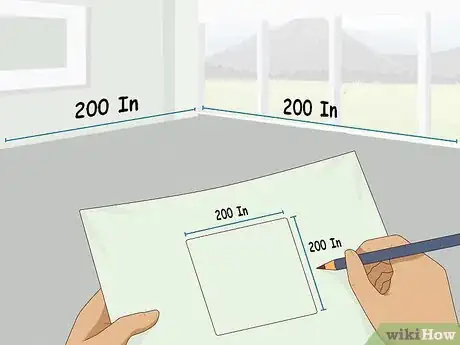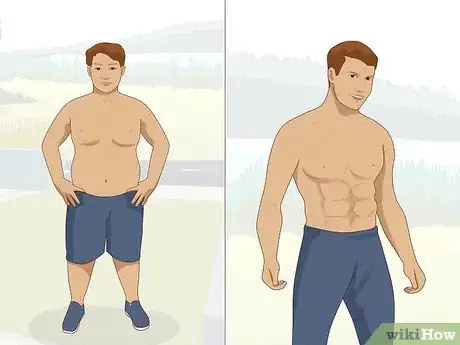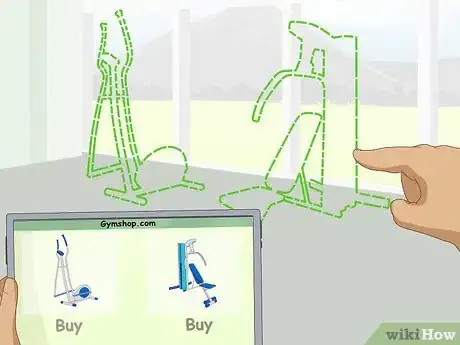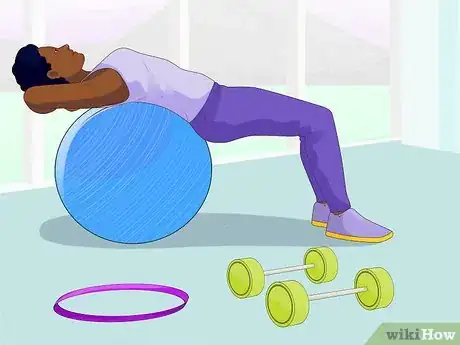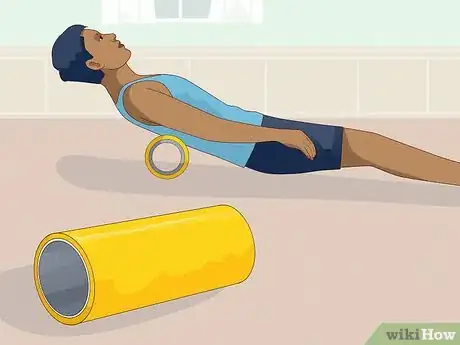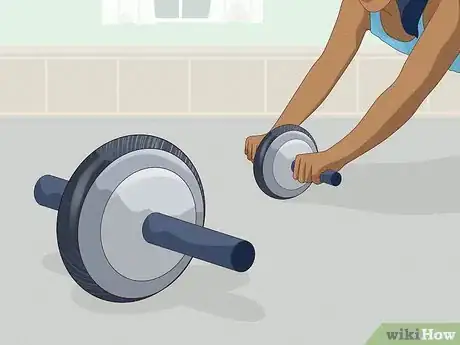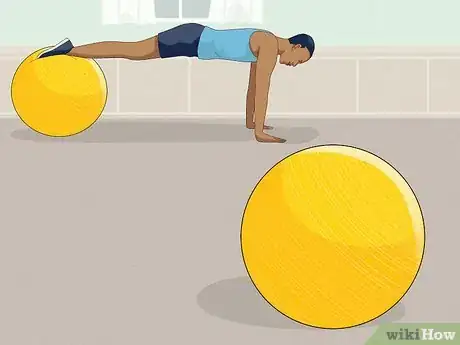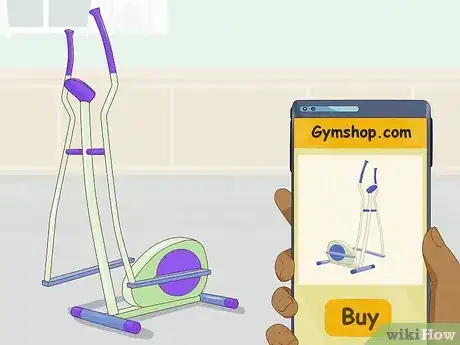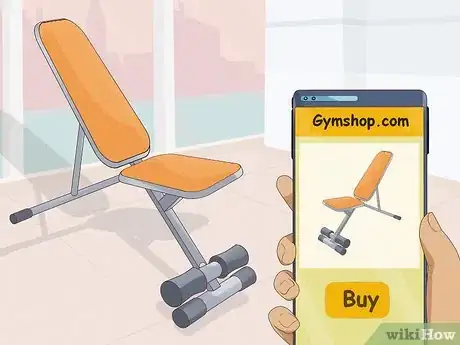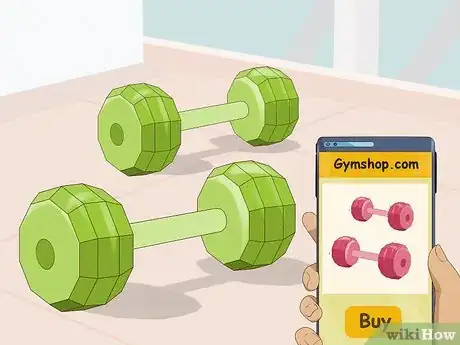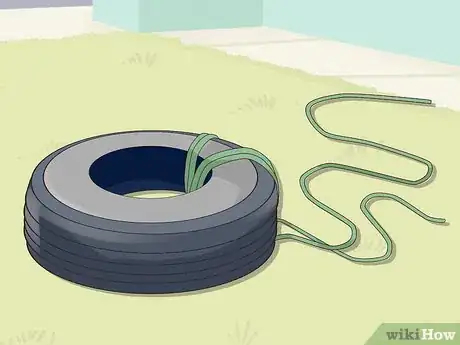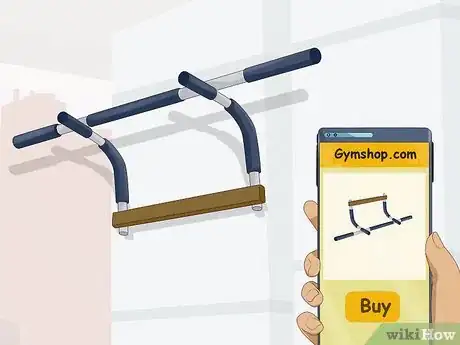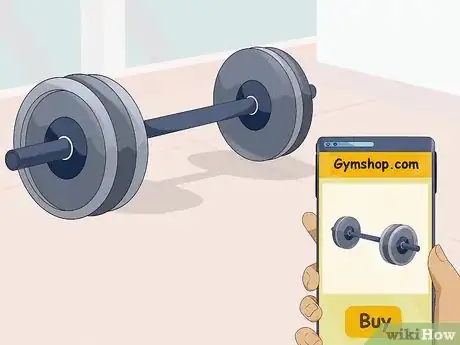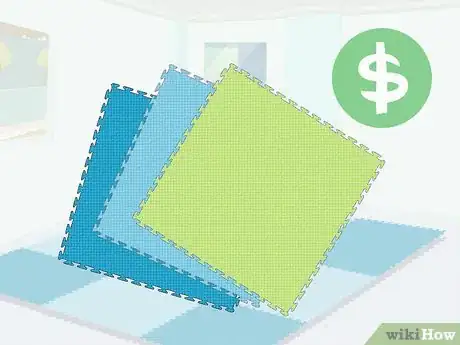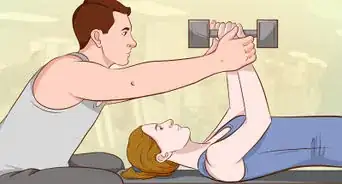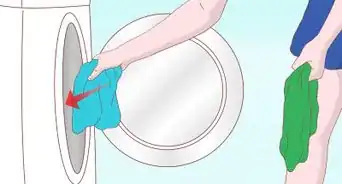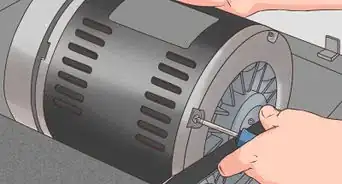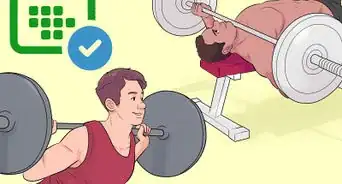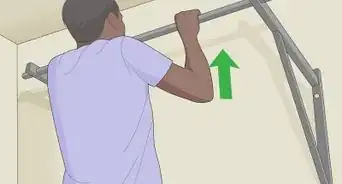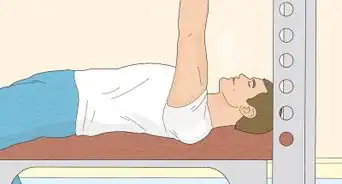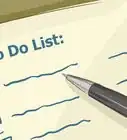This article was co-authored by Pete Cerqua. Pete Cerqua is a Certified Personal Trainer and Nutritionist. Pete is also a five-time best-selling author of books including "The 90-Second Fitness Solution" and "High Intensity Fitness Revolution for Women/Men" published by Simon and Schuster and Skyhorse Publishing. Pete has over 20 years of personal training and nutrition coaching experience and operates the 90-Second Fitness flagship studio in New York City.
There are 9 references cited in this article, which can be found at the bottom of the page.
This article has been viewed 375,818 times.
Between costly gym memberships and expensive equipment, it seems more and more that exercise is becoming some sort of privilege. There is also the pressure to make any home gym as fancy and comprehensive as those that require a subscription. However, provided you're willing to accept some alternatives to your favorite equipment, having a home gym on the cheap is only a few hundred dollars (or less) away.
Steps
Prioritizing and Planning
-
1Measure the dimensions of your workout space. Before you buy any equipment, you'll want to know how much room you have to store it in. Write down your measurements and have them on hand when you're shopping for supplies for your home gym.
- If you're converting a small space into a home gym, keep in mind that you may not have room for a lot of big equipment. Try to prioritize which equipment is most important to you.
-
2Decide what your fitness goals are. Knowing your goals will help you make smarter choices when you're buying equipment. Write your goals down and organize them by exercise type (endurance, strength, balance, etc) so you know what kind of equipment you should be getting.
- For example, if your goal is to work on your endurance, it may make sense for you to get a treadmill. But if you're only interested in building muscle, a treadmill probably isn't a good thing to spend your limited resources on.
Advertisement -
3Count the outlets in your workout space. If you want to buy workout machines for your home gym, you'll need somewhere to plug them in. If your workout space only has one outlet, it may be a hassle if you have 3 different machines. Keep that in mind when you're doing your shopping.
-
4Skip out on workout machines if you want to save more money. Workout machines can be expensive, and it's possible to do most workouts at home using weights, resistance bands, and an exercise ball. You can also install a pull-up bar so you can workout your back muscles without large equipment.
- If you feel like you need a workout machine, try to find one that's versatile so you get the most bang for your buck.
Buying for Cardio and Fitness
-
1Seek out equipment-less exercise. Particularly for cardio and general fitness, a lot can be accomplished with little financial investment.[1] The web is full of useful guides to full, high-intensity cardio workouts which require no equipment. Yoga and pilates are two disciplines which practice exercise using next to no equipment.[2]
-
2Buy a foam roller. One item that's accrued tremendous popularity in the past several years is the versatile foam roller. Basic, quality foam rollers can be found starting from $10. If you're looking for the even more cost-effective route, buy a length of PVC pipe at the hardware store and wrap it in a beach towel for a DIY foam roller.[3]
-
3Purchase an ab wheel. Whether to help your back or to change things up, you may be wanting to move past crunches and planks when exercising your abdominal muscles. An ab wheel is a simple, one-step solution to this problem. A common item, you should be able to find one for less than $20.
-
4Get a burst-resistant stability ball. These balls are one of the most versatile items in all of fitness. They are excellent for abdominal work as they support the spine and isolate the stomach muscles. A stability ball works the abs better than a crunch or sit-up. These balls are highly versatile. The ball may even take the place of a bench in some exercises.[4]
-
5Consider splurging for a cardio machine. Ideally this will be a stationary bike. Good quality stationary bikes can usually be found for only a couple of hundred dollars, whereas an equal quality treadmill might go well into the thousands. Stationary bikes are also adjustable, so you won't have to worry (as you would with an elliptical) about finding one that fits your body.
- Keep an eye out for gyms going out of business. Usually they'll offload their equipment to the public, and there's usually no cheaper way of buying quality equipment.
Buying for Strength
-
1Get a high quality adjustable bench. If you can only go big on one item, have this be it. An adjustable bench will replace the need for an incline bench, a flat bench, and a decline bench. One adjustable bench will save you hundreds of dollars compared to buying all three single benches. An adjustable bench is highly versatile and can be used in almost any exercise.[5]
- If an adjustable bench is out of your price range, use an exercise ball instead.
-
2Pick up a set or two of dumbbells. Dumbbells have long been hailed as the better choice among strength training equipment. They are much smaller than large home gym machines and much cheaper. If you could only buy one thing to go towards strength training, this should be it. Dumbbells/free weights will always form the foundation of any budget home gym.[6]
- If you are already quite strong you should get the standard Olympic dumbbells, which weigh about 12lb (unloaded) and can be loaded with up to 200lbs each.
- If you don't have the space to keep dumbbells, consider using resistance bands instead.
-
3Make some sandbags. If you happen to have spare construction materials this is a great way to make use of them. You'll also need an old duffel bag or exercise bags; fill either with sand or gravel and tape the opening up well. These can be used for any number of exercises which call for weight resistance.[7]
-
4Buy some resistance bands. The simplest and lowest cost of strength equipment, you can switch dumbbells for resistance bands in any exercise that uses them. Find a place to anchor one side of the band and you can emulate any standing machine to work out whatever your other equipment has left lacking.
-
5Build a pulling sled/tire. A bit of a DIY endeavor, building a pull sled is a cost-effective way of building leg strength and general physicality. The most basic recipe calls for simply a tow rope and a large tire; attach one to the other and you're good to go. Other more involved plans will usually involve some welding.
-
6Purchase a pull-up bar. Usually they can be found for no more than $15 to $20. Make sure you have a sturdy door frame in your home on which to use it. Try to buy one that doubles as a bar to do tricep lifts and push-ups; having one of these bars makes it much easier on your wrists when doing push-ups.
-
7Invest in an Olympic bar with bumper plates. If you can afford it, this big purchase will bring your strength training up a level. Bumper plates are more durable compared to ordinary plates as they're rubber coated and allow to be dropped on the floor. Barbells allow mini increments in weight used from 100GMS-1KG. This is highly useful for the higher level lifters who are plateauing.[8]
- Keep in mind that an Olympic bar with bumper plates will take up a lot of space.
Making It Complete
-
1Have it secluded. While not a consideration for the budget, do your best to have your home gym in a place of little disturbance. This will aid tremendously in committing to your exercise by cutting down on distractions, encouraging you to focus on the task at hand. Regardless of how much you spend, don't spend it on stuff you'll end up not using. Having a special place for it all gives a proper home and makes it less likely to be labelled "clutter."[9]
-
2Don't skip the flooring. Unless your home gym is floored with carpet, you should seriously consider buying some padded flooring, if only for a corner of the room. Necessary for yoga and other stretches, padded flooring is an advantage for all exercises. It will make most exercise much more comfortable by reducing the wear and tear faced by your knees and other joints.
-
3Keep a TV or stereo in the room. Take a cue from professional gyms and allow yourself a bit of distraction while working out. A television is doubly useful if you are a fan of exercise videos to follow along with. Music can also be an effective stimulant for your work-out; there have been studies linking music with the appropriate rhythm to longer-lasting work outs.[10]
-
4Consider buying wall mirrors. More than just a cosmetic touch, having a mirror to watch yourself exercise is helpful in troubleshooting any problems of form. Since you'll most often be exercising alone in your home gym, you won't have a partner to advise on your technique.
- Don't let looking good in the mirror drive your exercises, however. Be sure to target more than just the "show" muscles.
How Can I Set Up A Home Yoga Studio?
Expert Q&A
-
QuestionWhat equipment should I buy for a home gym?
 Pete CerquaPete Cerqua is a Certified Personal Trainer and Nutritionist. Pete is also a five-time best-selling author of books including "The 90-Second Fitness Solution" and "High Intensity Fitness Revolution for Women/Men" published by Simon and Schuster and Skyhorse Publishing. Pete has over 20 years of personal training and nutrition coaching experience and operates the 90-Second Fitness flagship studio in New York City.
Pete CerquaPete Cerqua is a Certified Personal Trainer and Nutritionist. Pete is also a five-time best-selling author of books including "The 90-Second Fitness Solution" and "High Intensity Fitness Revolution for Women/Men" published by Simon and Schuster and Skyhorse Publishing. Pete has over 20 years of personal training and nutrition coaching experience and operates the 90-Second Fitness flagship studio in New York City.
Certified Personal Trainer & Nutritionist Dumbbells are probably the most obvious purchase if you're doing any weight training, but it really depends on what you're doing and what your goals are. If you just want to do some light resistance training, you could buy resistance bands, a yoga mat, and light dumbbells. If you're into big muscle gains, you could definitely buy a full out bench press or barbell set. It really just depends on what you're trying to do.
Dumbbells are probably the most obvious purchase if you're doing any weight training, but it really depends on what you're doing and what your goals are. If you just want to do some light resistance training, you could buy resistance bands, a yoga mat, and light dumbbells. If you're into big muscle gains, you could definitely buy a full out bench press or barbell set. It really just depends on what you're trying to do. -
QuestionWhat is best adjustable bench or multipurpose gym machine for whole body workout?
 Community AnswerGo for an adjustable bench if you have access to weights and a few other equipment to help out with using it to its full potential. Otherwise, an MP gym machine should do wonders and save space.
Community AnswerGo for an adjustable bench if you have access to weights and a few other equipment to help out with using it to its full potential. Otherwise, an MP gym machine should do wonders and save space. -
QuestionCan I install a bar and do pull-ups?
 Community AnswerOf course. Look online for doorway pull-up bars, or build some pull-up bars outside.
Community AnswerOf course. Look online for doorway pull-up bars, or build some pull-up bars outside.
References
- ↑ Pete Cerqua. Certified Personal Trainer & Nutritionist. Expert Interview. 14 May 2020.
- ↑ http://greatist.com/fitness/50-bodyweight-exercises-you-can-do-anywhere
- ↑ http://www.builtlean.com/2013/02/20/build-home-gym/
- ↑ http://www.builtlean.com/2013/02/20/build-home-gym/
- ↑ http://www.telegraph.co.uk/men/active/11599648/How-to-create-the-perfect-home-gym.html
- ↑ http://lifehacker.com/get-buff-not-broke-how-to-build-a-budget-friendly-hom-1460079368
- ↑ http://www.artofmanliness.com/2009/04/23/the-diy-gym-8-pieces-of-equipment-that-will-get-you-strong-save-you-money/
- ↑ http://health.usnews.com/health-news/blogs/on-fitness/2009/03/20/how-to-get-a-cheap-workout-8-ideas-for-building-a-100-home-gym
- ↑ http://www.muscleforlife.com/affordable-home-gym/
About This Article
You can easily build a low-cost gym at home with only a few hundred dollars or less. To cut down on costs, start by buying equipment you know you’ll use frequently. If you’re a runner, it makes sense to buy a treadmill, but if you’re more into weightlifting you can probably skip it. If you want to lift weights, invest in a high-quality adjustable bench since this can be used for all sorts of exercises. Then, supplement bigger equipment with inexpensive but useful items like a yoga mat, an ab wheel, an exercise ball, dumbbells, and resistance bands. To learn how to put the finishing touches on your home gym, read more from our Training Co-author!
